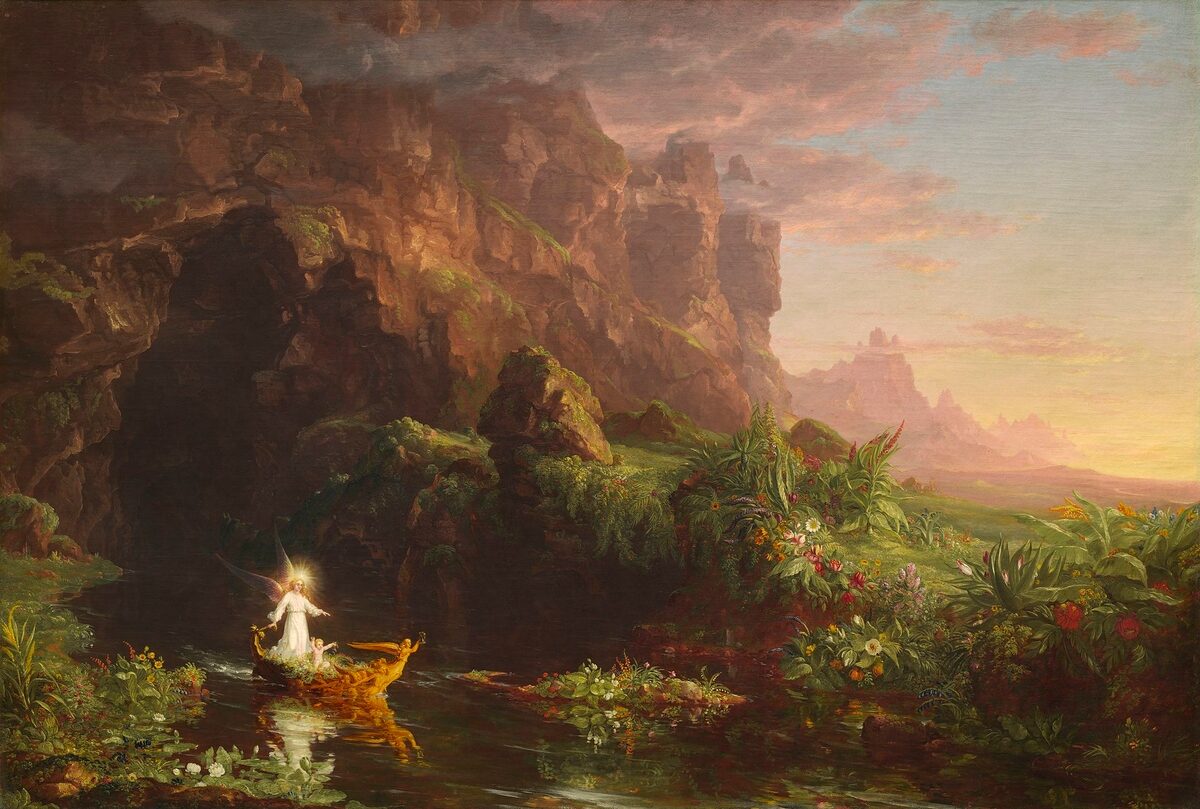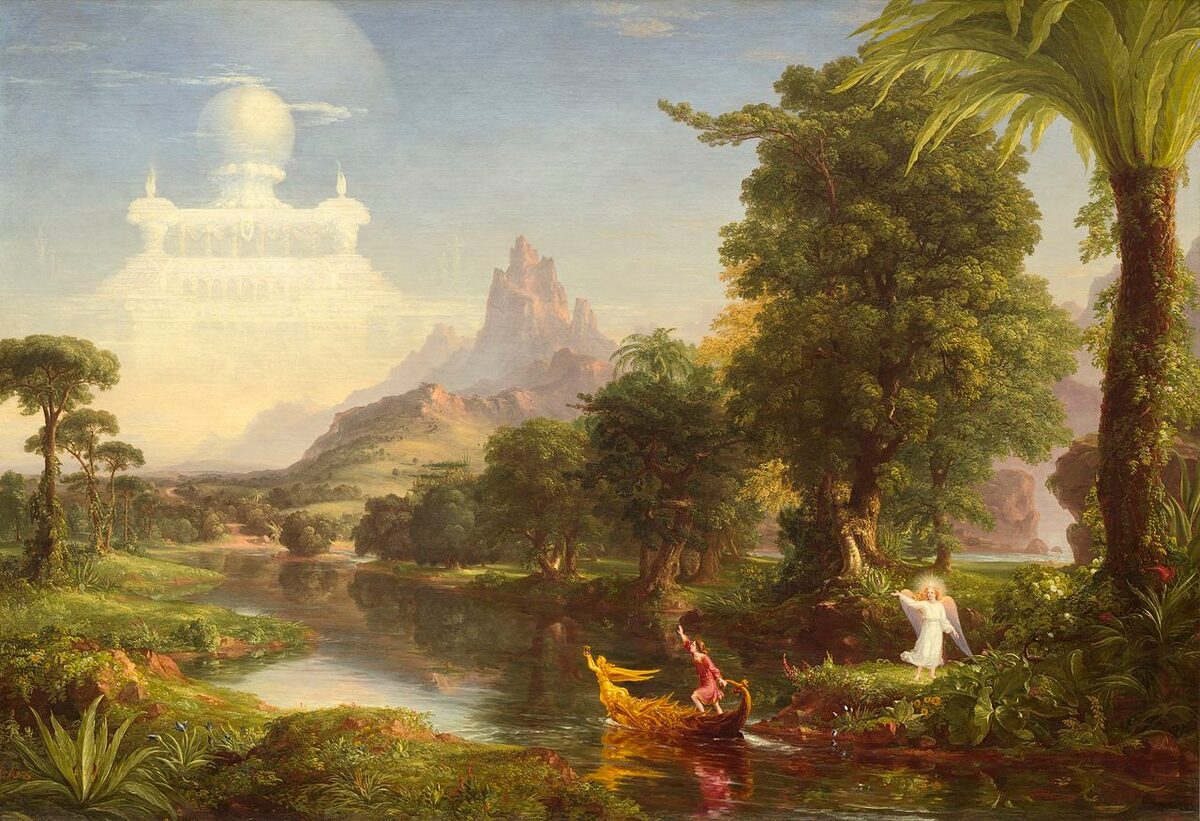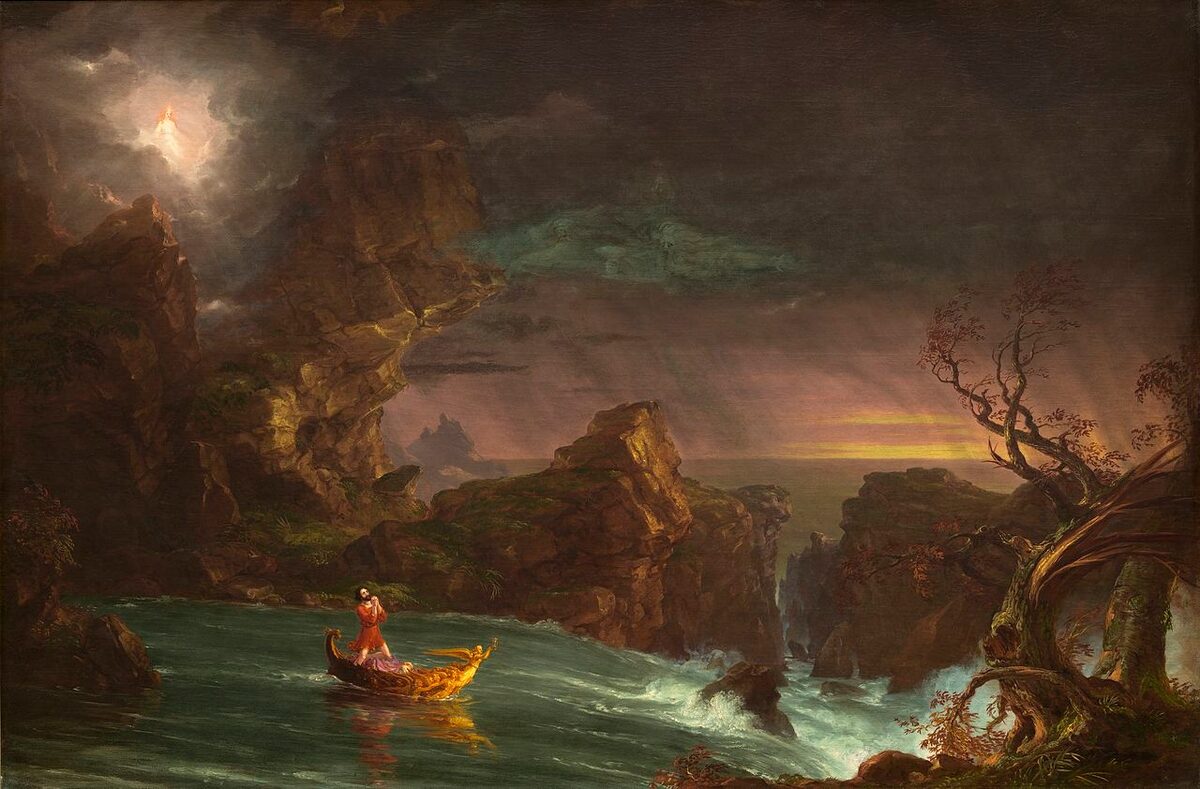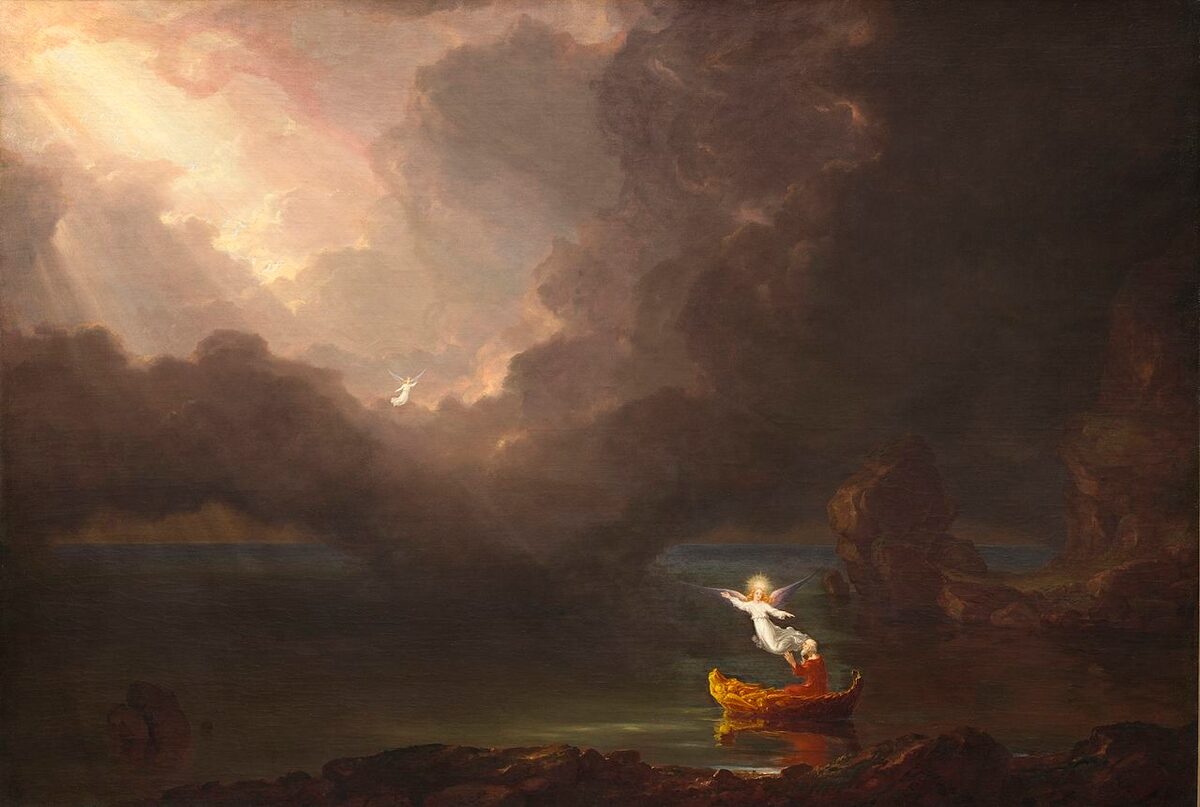The Artist as Exemplar: Thomas Cole’s Voyage of Life
“Remember that Life’s River swiftly hies…and thou hast much to do: |…he must trust in God and strike, | Who conquers in the fight.”
In my previous column on the fine artist Thomas Cole’s life and his early series The Course of Empire, we explored the classical liberal perspective of history in theory and practice, both in tandem and at odds. The most hopeful, visionary, and romantic liberal activists of the day (ca. 1820s-1850s) embraced the American position in history and their own individual and collective abilities to shape time. The more pessimistic (perhaps realistic), cautious liberals inclined toward theory and doubted the tools activists chose to sculpt free society. While his optimistic, locofoco peers in the Young America movement championed national power and global republicanism, Thomas Cole lamented his country’s feverish departures from pure theory. Cole and his democratic contemporaries largely shared the same liberal theory of history, explaining change over time throughout all social units with reference to the cyclical conflict between individuals’ interests in liberty and power. Despite their shared theory, Cole and the democratic Young Americans sharply divided in applying historical knowledge to present-day action.
In his paintings, Thomas Cole attempted to convey the wisdom of the ages to those precious few in the audience that may actually listen. The Course of Empire followed the life cycle of a full civilization, warning that a society which maintains insufficient virtue and reverence for liberty cannot check the growth of concentrated power. When a society’s exercise of power so outstrips its love of liberty, that society invites its own destruction, whether from rebellion within or conquest from without. From world history to civilizations, nation-states, communities, and every unit in between, right down to the individual life cycle, Cole believed this cyclical dynamic was the narrative key to explaining change over time. While exhibiting The Course of Empire in 1836, Cole was inspired to produce a similar series chronicling the same historical dynamics in the life cycle of a single individual. From 1838 to 1843, Cole developed the idea for The Voyage of Life in verse, translating poetry and history into a masterful visual representation of theory and narrative.
Part One: Childhood

In the poem which inspired the later series of paintings, Cole explored history through the microcosm of a single individual during the phases of the life cycle. Man begins his life as an infant full of wonder upon encountering the natural world for the first time. In the days of his Childhood, man’s existence is lush, full of life and nurturing abundance. The future appears magnificently bright on the horizon and the river gently drifts the babe forward. Man’s guiding angel steers life’s vessel from the cavern’s opening. The darkness of the cliffs and cave is firmly behind the newborn, while nothing seems to await him but soft pastels and the stillness of undisturbed Nature.
The poem uses the voice of an unnamed narrator to tell the story of the life cycle. While adventuring through a mountain cave, the narrator encounters the river, boat, child, and guardian angel with a mixture of wonder and concern. “What meaneth this,” he demands of the scene in general. His soul replies, “By thee now standing midway on the height | Of contemplation not alone are seen | Pictures of the departing past; but sight | Of future scenes is opened through a screen | Of darkling clouds and mists fantastic lies | Across the tearful vision of thy longing eyes.”
Accepting the scene as a sort of prophetic vision, the narrator’s soul continues, “By mortal man that River of dark source | Is named the ‘Stream of Life;’ with constant flow | With many a winding on its downward course, | At times it lags along with motion slow, | At times impetuous o’er the rocky steep | It journeyeth onward toward The Eternal Deep.” The unwary traveler of this river--while undoubtedly pleased with his initial surroundings and situation--will all too soon plunge into “that vast Profound--that darkest Dread | That Silence--that immeasurable Gloom, | The Breathless--Shoreless--the Un-islanded | Of the great World--of mighty Time and Tomb.”
The narrator’s soul certainly strikes a chord with the pessimists among us, those of us who believe it better to learn hard lessons about life sooner rather than later. Far from promoting despair, however, our narrator reminds himself that “human thought, thanks be to God, can soar | Triumphant on the wings of light divine | And take its flight above the Shadow hoar; | Where Angels in a land of beauty shine | In living light which is the Light of Light, | The everlasting day, that suffereth not the night.” He continues to muse about the relations between one life cycle and another, the comparison between the developing vision and his own life in the real world. The narrator’s soul continues, “Thou wert such infant Voyager, all men | Have been--the thousands yet unborn will be.” The innocence of childhood shielded the ship-bourne subject, “For withering sin, as yet, can claim no part | Nor pale remorse bedim the beaming eye. | Children are buds of Heaven ‘tis earthly air | That breeds the cankers, guilt and deadening despair.” Guarded by heaven’s Angels, individuals may rely upon God’s protection throughout their lifetimes, “And nought but Giant Sin can drag us thence | Who grows and conquers by our disobedience.” When our narrator demands that the vision explain why innocent childhood does not last forever, his soul replies, “A higher destiny is thine…through trial, sorrow, darkness, pain | The road to far sublime joys does lead | And lasting bliss by suffering we gain | And by the gloomy value through which we tread | We reach the bliss that makes all earthly joy seem dead.”
Part Two: Youth

During his youth, man gains greater knowledge and self-confidence, literally taking the helm of life’s ship from his personal angel. While the angel maintains a watchful, caring eye over the young man, our subject’s gaze is fixed upon the distant celestial temple. In a rush to reach the greatness and grandeur which lies ahead, our youth bids farewell to the stillness, beauty, and plenty in the current frame. He steers life’s vessel away from shore, downriver to the twists and turns of fortune and fate. Self-assured, over-confident, and yet lacking in necessary experience and virtue, the youth exercises his powers over Nature in an effort to exercise mastery over his world, turning it to his serve his own ends. “So changed my thought from light to shade,” comments Cole’s poet-narrator, “At times exulting in the glow of hope, at times | In darkness cast by what my soul had said; | ‘Till sunk in reverie her words seemed chimes | From some far tower.” Even our narrator--blessed as he was with the gift of historical foresight, fully aware of the dangers lurking beyond the bend--has fallen to the lustful, romantic passions of youth.
The youth’s world is immediately exciting and pleasing. It bustles with fauna, bursts with flora, and continually beckons both subject and narrator alike. Entranced, they proceed ever onward, “Toward the ethereal mountains which did close | Fold beyond fold until they vanished | In the horizon’s silver, whence uprose | A structure strangely beautiful and vast | Which every earthly fane Egyptian, Gothic, Greek surpassed.” The youth’s focus, irrevocably drawn forward with a passionate yearning for greater liberties to explore his world and greater powers with which to do so, is absorbed by the cloud temple. In fact, when one concentrated enough, intent on discovering all he might accomplish, a youth may catch sight of an endless array of gilded pinnacles and domed heights: “Above the columned pile sublimely rose | A Dome stupendous; like the moon it shone | When first upon the orient sky she glows | And moves along the Ocean’s verge alone; | And yet beyond, above, another sphere | And yet another, vaster, dimly did appear.” Such was the dizzying, dazzling ambition of youth, it was “As though the blue supernal space were filled | With towers and temples, which the eye intent | Piercing the filmy atmosphere that veiled, | From glorious dome to dome rejoicing went, | And the deep folds of ether were unfurled | To show the splendors of a higher world.”
Finally peeling his gaze from the celestial temple, the narrator takes keener notice of the youthful Voyager, remarking that “Now stood a Youth on manhood’s verge, his eye | Flashing with confidence and hot expectancy.” The youth maintained singular focus on the cloudy castle and “His bosom heaved as if with the secret powers | Possessed to tread the deep--to outstrip the flying Hours.” Youth’s angel bids him farewell from the shore, and the narrator’s soul returns to the scene to enlighten the narrator: “The scene before thee beautiful and bright | is but a phantasm of Youth’s heated brain | And doomed to fade as day before the night, | Fleeting its glory, transitory, vain; | Save that it teaches the meek humble soul | Earth’s grandeur ne’er should be the spirit’s Goal.” A truly virtuous life and real heavenly rewards required diligent toiling in one’s own garden. “But mark the Youth,” the soul continues, “how filled his eager eye | With the bright exaltation--See! He aims | To reach the portal of the palace high…The tempting semblance of a conqueror’s crown | And wreath to bind the brows of him who wins renown.”
The narrator’s soul stands in righteous judgment of the youth, whose actions betray a nature both reckless and acquisitive. “We and deluded one!” the soul-voice castigates Youth, “Dost thou not know | Thy Bark is hasting down the Stream of Life | And tarries not for any golden show…Does not thine eye perceive that when yon towers | Are well nigh gained with sudden sweep the stream, | And growing swiftness, shoots away and pours | Impetuous, towards a shadowy raven deep | Cleft in the mountain’s vast and misty side.” At the notion of Youth’s impending doom, the narrator again demands the vision account for the Angel’s absence given “That hand divine could steer | The willing boat to where yon glittering domes uprear.” A loving god, it would seem, would provide that “E’en youth might live a long long life of joy | And shun perchance the torrent where it pours | Adown yon dread descent.” His soul responds that there is no accounting for the ways of divinity, but the Voyager himself is most obviously to blame. After all, “Through feeble infancy is steered the Bark of Life | By Angel hands; but growing man demands | The helm in confidence and dares the strife | Of the far-sweeping waves. The lurking sands, | The rapids foaming through the channel dim, | The roaring cataract are all unknown to him.” Thus do heavenly forces create wisdom out of man’s arrogant, youthful folly, as “from man’s conflicts with the world arise | A sense of weakness and of chilling fear | And driven from earth his hopes ascend the skies. | Thus is he launched upon the stream alone | To chasten pride and give young desire a holier tone.”
Part Three: Manhood

Upon entering manhood, our subject cannot help but realize the follies of youthful arrogance and inexperience. Clearly unaware that the once-calm river led directly and inevitably to a thicket of craggy rapids, the youth lusted after the power to reach the Heavens. So badly did he yearn for selfish liberty and selfish power, that he endangered his own well-being in the pursuit. With age, man gains wisdom and repents his sins. The subject prostrates himself before the now-unknown forces mastering his world, begging them for clemency and protection. He is lost and virtually without hope. It is only when he has reached the point of no return and ultimate danger that man finds it within himself to admit his own failings. The ever-watchful angel, meanwhile, patiently waits for the subject to weather the struggles ahead; the angel waits to rebuild a battered, broken, and humbled man.
In the poem, it seems to our narrator that “the Earthquake there had oped his jaws | And fierce Convulsion rent the ribs of Earth; | Darkness and light forgot their ancient laws.” So dark were the depths of man’s depravity and lust for power, the stretch of craggy rapids “was a den where demons had their birth | Where voices strange and many a dusky form | Smote the strained ear and did the sky deform…Where fear and death forever hover round.” The river coursed quickly onward, “with a tyrannic force,” tossing jagged bits of rock as casually as it tossed sprays of foam, and “Like famished wolves when the scared prey is nigh, | The pale demoniac roared louder as for joy.” At the very moment of certain death, the Voyager casts himself before Nature’s god, pleading with the unknown forces of his world. “This is the crisis,” the narrator’s soul explains, “tis the decisive hour | In life’s swift fever-balance Life and Death. Adversity’s cold storm and Sorrow’s power | Temptation desperate with changeful breath | Break with unmitigated fury on the Man, | And Pleasure once so fair is sicklied o’er and wan.” The Voyager’s youthful lust for power has failed and mastery over the material powers of the earth remains well beyond his actual grasp. In the process, he has abandoned friends, acquired enemies, and lost his childhood innocence. The angel stands by to observe as man reaps the just and natural rewards for his inexperience and systematic lack of virtue.
Part Four: Old Age

In his old age, man once again returns to the serenity and stillness of his childhood. He has sufficiently humbled himself before the God of Nature and His angelic representatives. Man has given himself to the course of nature without exercising the selfish, reckless pursuit of either liberty or power. He has seen visions of grandeur and fallen prey to them. He has seen death pressing in from every corner, a sharp, angular world full of nothing but stabbing, rushing madness. He has, ultimately, realized that the world is no kingdom, and he is no king. He is, in fact, a lone individual trapped in Nature’s river of history. Man can choose to forsake the serenity and peace which attends individual humility, or man can exercise his extraordinary powers to warp nature into more pleasing forms. Cole’s lesson in The Voyage of Life, as in The Course of Empire, is that when we indulge ourselves with the belief that we can master nature and change the course of history, we are in fact simply pushing forward the cyclical course of the natural world. We can never master nature, and despite our pretensions to power and our abuses of natural liberty, we remain the subjects of nature and Nature’s God.
“There sat the Voyager,” the poem’s narrator states with a note of pity, “an ancient Man, | Withered and blighted by the frosts of time: | Furrowed his cheek, his forehead bare and wan | As though the tempests of each earthly clime | Had broken o’er him in their fiercest mood | And he with patient soul their fury had withstood.” The guardian angel finally returns to her charge, the flames surrounding her lighting the way for the old man’s ascension to Heaven. With the man’s death, our narrator is cast out of the vision and awakens thrown to the ground. “There long I lay mingling my sighs and tears, | Recalling all the Vision to my mind, | Its varied scenes, its many hopes and fears | Its seasons four mysteriously combined, | How through bright Childhood’s vale the river flowed | Youth, Manhood, Age, to reach the mighty flood.” The narrator’s soul once again responds by inciting him to action: “Rise | Dwell not inactive on the Vision true | Remember that Life’s River swiftly hies | Toward the great Deep and thou hast much to do: | The Vision teaches when divined aright | That he must trust in God and strike, | Who conquers in the fight.” 1
Cole’s The Voyage of Life in Historical Context
Thomas Cole’s inspirational, masterful, and thoroughly influential career as a visual artist propelled him to stardom within both elitist Knickerbocker and locofoco Young American cultural circles in New York City. He was accepted and loved by Americans of all sorts as an undoubtedly brilliant, original, and wise artist; a credit to his nation and its unique place in world history. Yet Cole himself was not nearly so optimistic, and as we saw in The Course of Empire, he feared impending national doom. In the Jacksonian period, pessimists like Cole may have inspired optimists like O’Sullivan, the Loco-Focos, and others explored in Libertarianism.org’s ever-expanding catalogue of primary sources, but Cole feared their virtue failed to match their vigor. He was correct.
Young Americans surged to the polls behind James K. Polk in 1844 and rushed headlong into war with Mexico, their minds clouded with dreams of a great Continental Republic. Thomas Cole, the young Walter Whitman, and a sizeable portion of the American population opposed the war as a barbaric attempt at annexation and a sop to the southern slave power. They feared, too, that the impending firestorm over slavery in the territories would consume and destroy the country. The Jacksonian era, then, was to Cole’s mind the point of Consummation; the days of Polk ushered in Destruction; leaving the youth a Desolation fresh and new, ready to begin the cycle once again. Perhaps--if individuals like himself could impute the right message in the right ways--future generations would have a better chance to improve history’s course.
All such hopes, Cole suggests to his audience, rest on individual moral agents and their virtue. The Voyage of Life and its attendant series of paintings suggests a dual moral mandate: individuals have obligations to both “trust in God,” and “strike.” We have the opportunity to use history like the narrator’s vision. Our knowledge of the past allows us to understand the world better and transcend the moral failings of our ancestors. When we fail to do so, we fail to heed God’s commandments and cast away our angelic guardians. Should we remain firmly rooted in our life’s vessel, allowing ourselves to be guided entirely by our knowledge of the natural order, we would greatly ease our individual voyages through history. Doing so, we will not avoid life’s calamities and catastrophes, but we will be sufficiently prepared to meet them and overcome a long series of celestial tests. Thomas Cole believed his own world of Jacksonian Manhood still unrepentant of its evils, but within that pessimistic view layed an entrancingly optimistic declaration: each and every one of us changes history when we resolve to change ourselves and be better than our forebears.
1. Marshall Tymn, Thomas Cole’s Poetry: The Collected Poems of America’s Foremost Painter of the Hudson River School Reflecting His Feelings for Nature and the Romantic Spirit of the Nineteenth Century, (York, PA: Liberty Cap Books), 1972, 144-172.